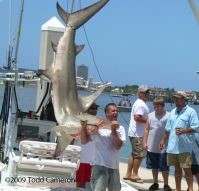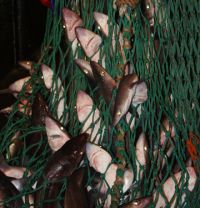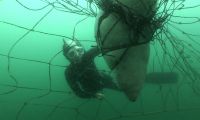
There has been a lot of attention placed on the impact of commercial fishing on shark populations, which is well warranted considering the sheer scale of the catches. However, the overall impact of recreational fishing on shark populations is not well studied and is typically difficult to detect.
Recreational fishing for sharks is popular in many places like the United States, Australia, New Zealand, and the United Kingdom (Babcock 2008). Several species are targeted by recreational fishermen, such as blue sharks, shortfin mako, porbeagle, and thresher sharks (Camhi et al. 2009).
Some recreational shark fishermen do practice catch and kill techniques just for fishing records or to obtain jaws or mounts as trophies. Despite the fact that most sport fishermen are responsible stewards of the sea, some fishermen do heavily target sharks and may have a significant impact on some species, such as bull sharks (Casey and Hoey 1985) and blue sharks (Campana et al. 2006). Reports from this type of tournament indicate that fishermen have caught and killed large pregnant females and sharks of threatened species.
Fishermen and tournaments are changing to catch and release techniques. The most important aspect of this fishing is how the shark is caught, handled and released. If proper techiques and guidelines are not followed, the shark may become stressed and if released, it may not survive. Some sharks are more susceptible to death after release than others. Therefore, fishermen engaging in catch and release shark fishing need to be familiar with the species they may encounter and know how to quickly and efficiently get the shark off the hook and back in the water. Catch and release fishing should also be done carefully near areas of vulnerable shark populations, such as nursery and pupping grounds (Gallagher et al. 2012).

Humans have utilized sharks throughout history. The fishery for and trade in shark liver oil, called Squalene, started because the compound was used as machine lubricant but was subsequently replaced by synthetics. Now, Squalene is marketed as an expensive ingredient in cosmetics and lotions (Vannuccini 1999) and is being sold in the form of a pill as a health supplement, the benefits of which are still inconclusive.
The fisheries targets deepwater sharks because their large livers, constituting up to 30% of their body weight. These deepwater sharks are among the most vulnerable to overexploitation because of an extremely low reproduction potential, even for sharks (Kyne and Simpfendorfer 2007)! The liver oil trade caused the collapse of the Gulper shark fishery in the Maldives, only 20 years after it started (Adam et al. 1998). The Portuguese shark (Centroscymnus coelolepis) is also heavily targeted for their Squalene resulting in a declining overall abundance (OSPAR 2010).
The hydrocarbon compound that makes up Squalene can be extracted from other sources, such as palm oil, which can be obtained or farmed in a more sustainable method than the overharvesting of vulnerable deep-sea sharks.
Coastal development has increased significantly in the past century which has altered habitats, increased levels of pollution and resulted in the general environmental degradation in many areas. Many shark species use inshore coastal and estuarine habitats as a safe place for finding food, giving birth and growing up away from predators and competitors. This means that they are vulnerable to negative changes in their habitat. For example, dredging in the Bahamas resulted in a 25% decline in juvenile lemon shark survival (Jennings et al. 2008). Juvenile bull sharks have been known to be trapped in the warm water outfalls of power plants in Florida, USA, causing the sharks not to partake in seasonal migrations and if the water from the power plant does not flow, the sharks may succumb to thermal shock, thermal stress and may cause the sharks to cease seasonal migrations (Simpfendorfer and Burgess 2009).
Sharks are very susceptible pollution and environmental contamination. Pollution in the ocean has either filtered from land activities or has been directly deposited into the seas. As apex predators with slow growth, they accumulate all the pollutants and toxins in the environment and bioaccumulating all the toxins of their prey. Chemical pollution, in the form of mercury, DDT, organochlorines, etc., has been documented in several shark populations in close proximity to areas of human populations. Bull sharks in Florida have been found to have levels of pharmaceuticals that are disposed of through waste water discharge. But the effects of pollution are not just liited to the shark species that hang around developed areas. The Greenland shark is a deep water shark that likes remote locations of the colder seas. However, there have been high levels of contaminants found in these sharks, further evidence that pollution is a global problem.
Pollution is not only chemical, it can come in the form of discarded fishing gear and plastics that can entangle and injure or kill sharks and other marine life. Whether it is discarded plastic toys, a Frisbee has been found like a noose around a sharks gills, or miles of discarded longline filament, or gillnets that were lost by the fishermen, each poses a serious threat to sharks and many other marine species.

Shark nets, also called beach meshing programs or beach protection programs, are essentially a form of shark fishing while supposedly providing bather protection. Shark control programs have been utilized in several places, including New South Wales and Queensland, Australia and KwaZulu Natal (KZN), South Africa.
Along Hong Kong beaches, the nets are designed to keep bathers separated from the sharks, a very expensive system to maintain. The controversy is whether shark control in any form is justified in a wild area where humans choose to enter while some believe it should be a case of “swim at your own risk”. The Natal Sharks Board (NSB), responsible for the nets in South Africa, believes that the nets have done a remarkably good job protecting bathers. But at what cost?
The catch of this ‘fishery’ in KZN alone includes great white sharks (protected in South Africa since 1991), tiger sharks, hammerheads, turtles, dolphins, and rays, among other sealife and bycatch. The nets are a culling program, not a barrier intended to keep sharks away from bathers, as 35% of sharks caught in the net are headed off shore (Dudley 1995).
The shark nets were put into place in KZN in response to public outcry when several shark bites occurred over a few days in the 1950s. Once measures have been put into place, it is difficult to convince the tourism industry and the water-users that the nets are not crucial to their survival. The installation of shark nets reinforces our misguided and often times irrational fears of sharks, providing a very real example that our concerns are valid. This in turns fuels the biggest issue faced in shark conservation: public apathy or even loathing towards sharks.
The installation of shark nets reinforces our misguided and often times irrational fears of sharks, providing a very real example that our concerns are valid. This in turns fuels the biggest issue faced in shark conservation: public apathy or even loathing towards sharks. Socio-political pressure may make the removal of the nets difficult but awareness campaigns may educate the public about the detrimental impact the nets have on local and migratory sharks and other marine animals. There are better ways to protect swimmers that don't indiscriminately kill sharks and other marine life. Since the installation of these nets, we have learned so much about sharks and the dire status of their populations that there is no excuse to continue an archaic and destructive practice when it is well understood that the actual risk of an incident is slim.
In some parts of the world, including the United States, money is made on the sale of shark parts as souvenirs. Some recreational fishermen target large sharks to make a trophy from the jaws, which can sell for hundreds of dollars. Since the meat from these large sharks is not edible, the rest of the shark is wasted. In other places, such as Mexico, souvenir jaws from all sizes and types of sharks, including baby sharks, can be found in tourist shops. Sharks’ teeth are another popular item found at souvenir shops, as well as small or baby sharks in jars of formaldehyde.
Adam, M.S., Merrett, N.R. and Anderson, R.C. 1998. Additions to the fish fauna of the
Maldives. Part 1: An annotated checklist of the deep demersal fishes of the Maldive Islands.
Ichthyological Bulletin of the JLB Smith Institute of Ichthyology 67(Part 1):1-19.
Babcock, E.A. 2008. Recreational fishing for pelagic sharks worldwide. In: M.D. Camhi, E.K. Pikitch and E.A. Babcock (Eds.), Sharks of the Open Ocean: Biology, Fisheries and Conservation, pp. 193-204. Blackwell Publishing, Oxford.
Camhi, M.D., S.V. Valenti, S.V. Fordham, S.I. Fowler and C. Gibson. 2009. The Conservation Status of Pelagic Sharks and Rays: Report of the IUCN Shark Specialist Group Pelagic Shark Red List Workshop. IUCN Species Survival Commission Shark Specialist Group, Newbury
Campana, S. E., Marks, L., Joyce, W., and Kohler, N.E. 2006. Effects of recreational and commercial fishing on blue sharks (Prionace glauca) in Atlantic Canada, with inferences on the North Atlantic population. Canadian Journal of Fisheries and Aquatic Science, 63: 670-682.
Casey, J.G. and Hoey, J.J. 1985. Estimated catches of large sharks by US recreational fishermen in the Atlantic and Gulf of Mexico. Shark catches from selected fisheries off the US East Coast. NOAA Technical Report NMFS SSRF.
Dudley, S.F.J. 1995. Shark control measures: the Natal Sharks Board and shark conservation. Shark News, 4: 1-2.
Gallagher, A.J., Kyne, P.M., and Hammerschlag, N. 2012. Ecological risk assessment and its application to elasmobranch conservation and management. Journal of Fish Biology, doi: 10.1111/j.1095-8649.2012.03235.x.
Jennings, D. E., Gruber, S. H., Franks, B. R., Kessel, S. T. & Robertson, A. L. (2008). Effects
of large-scale anthropogenic development on juvenile lemon shark (Negaprion brevirostris)
populations of Bimini, Bahamas. Environmental Biology of Fishes 83,
369–377.
Kyne, P.M., and Simpfendorfer, C.A. 2007. A collation and summarization of available data on deepwater chondrichthyans: biodiversity, life history and fisheries. A report prepared by the IUCN SSC Shark Specialist Group for the Marine Conservation Biology Institute.
OSPAR. 2010. OSPAR Commission. Background Document for Portuguese dogfish Centroscymnus coelolepis.
At: http://qsr2010.ospar.org/media/assessments/Species/P00469_Portuguese_dogfish.pdf.
Simpfendorfer, C. & Burgess, G.H. 2009. Carcharhinus leucas. In: IUCN 2011. IUCN Red List of Threatened Species. Version 2011.2. <www.iucnredlist.org>. Downloaded on16 March 2012.
Simpfendorfer, C. A., Heupel, M. R., White, W. T. & Dulvy, N. K. (2011). The importance
of research and public opinion to conservation management of sharks and rays: a
synthesis. Marine and Freshwater Research 62, 518–527.
Sumpton, W.D., Taylor, S.M. Gribble, N.A., McPherson, G., and Ham, T. 2011. Gear selectivity of large-mesh nets and drumlines used to catch sharks in the Queensland Shark Control Program. African Journal of Marine Sciences, 33(1): 37-43.
Vannuccini, S. 1999. Shark Utilization, Marketing and Trade. FAO Fisheries Technical Paper 389, Rome, 470 pp.